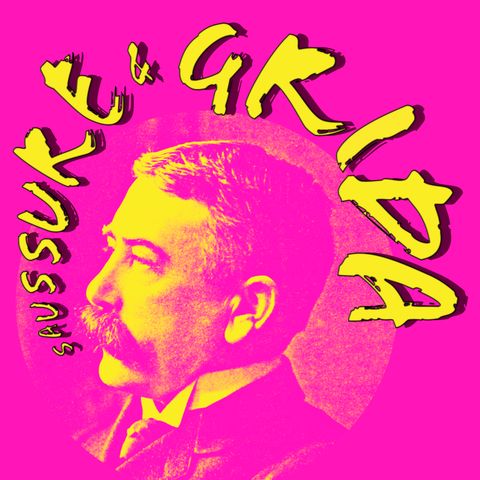13. Di lingue dei segni, LIS e abilismo

Regístrate gratis
Escucha este episodio y muchos más. ¡Disfruta de los mejores podcasts en Spreaker!
Descarga y escucha en cualquier lugar
Descarga tus episodios favoritos y disfrútalos, ¡dondequiera que estés! Regístrate o inicia sesión ahora para acceder a la escucha sin conexión.
Descripción
Questo episodio esplora le lingue in modalità visivo-gestuale, smontando alcune credenze diffuse che potrebbero portarci a fraintendere la vera natura delle lingue segnate. Durante la puntata, esamineremo da vicino alcune...
mostra másGrafiche: Gianluca La Bruna
La sigla è stata prodotta da White Hot e fornita da https://freebeats.io
FONTI:
- Cardinaletti, A., & Repetti, L. (2008). Vocali epentetiche nella morfologia dell’italiano e dei dialetti italiani. In R. Maschi, N. Pennello, & P. Rizzolati (Eds.), Miscellanea di studi linguistici offerti a Laura Vanelli da amici e allievi padovani. Udine: Forum Editrice. 24.
- Cecchetto, C., Geraci, C. & Zucchi, S. (2006). Strategies of relativization in Italian Sign Language. Nat Language Linguistic Theory 24:945–975.
- Corbett, G. (2000). Number. Cambridge Textbooks in Linguistics. Cambridge: Cambridge University Press. pp. 26–30
- Corina, D., & Singleton, J. (2009). Developmental social cognitive neuroscience: Insights from deafness. Child Development, 80(4), 952–967.
- Dye, M.W.G., Hauser, P. C., & Bavelier, D. (2009). Is Visual Selective Attention in Deaf Individuals Enhanced or Deficient? The Case of the Useful Field of View. PLOS ONE, 4(5), e5640
- Eberhard, D.M., Simons, G.F., & Fennig, C.D. (Eds.). (2023). Ethnologue: Languages of the World. Twenty-sixth edition. Dallas, Texas: SIL International. Online version.
- Figueras, B., Edwards, L., & Langdon, D. (2008). Executive Function and Language in Deaf Children. The Journal of Deaf Studies and Deaf Education, 13(3), 362–377.
- Fontana, S., Corazza, S., Braem, P.B., & Volterra, V. (2017). Language Research and Language Community Change: Italian Sign Language, 1981–2013. Sign Language Studies, 17(3):363–398.
- Geraci, C. (2012). Language Policy and Planning: The Case of Italian Sign Language. Sign Language Studies, 12(4):494-518
- Kegl, J., & Iwata, G. (1989). Lenguaje de Signos Nicaragüense: A pidgin sheds light on the “creole?” ASL. Proceedings of the Fourth Annual Meeting of the Pacific Linguistics Conference. Eugene: University of Oregon.
- Nuckolls, J.B. (1999). The Case for Sound Symbolism. Annual Review of Anthropology, 28:225-252.
- Ortega, G. (2017). Iconicity and sign lexical acquisition: A review. Frontiers in Psychology, 8, Article 1280.
- Perniss, P., Pfau, R. & Steinbach, M. (2017). Can’t you see the difference? Sources of variation in sign language structure. In P. Perniss, R. Pfau & M. Steinbach (Eds.). Visible variation: cross-linguistic studies on sign language structure (pp. 1-34). Berlin: Mouton de Gruyter
- Perniss, P., & Vigliocco, G. (2014). The bridge of iconicity: From a world of experience to the experience of language. Philosophical Transactions of the Royal Society B, 369, 20130300.
- Petitta, G. (2012). Sordo, sordomuto, non udente nella stampa italiana contemporanea. Bollettino di Italianistica 2:171–183.
- Pinker, S. (1994). The Language instinct: how the mind creates language. London: Harper Perennial.
- Sandler W., & Lillo-Martin D. (2006). Sign Language and linguistic universals. Cambridge: Cambridge University Press.
- Senghas, A. (1994a). Nicaragua’s lessons for language acquisition. Signpost: The Journal of the International Sign Linguistics Association, 7:1.
- Senghas, A. (1994b). The development of Nicaraguan Sign Language via the language acquisition process. In D. MacLaughlin & S. McEwen (Eds.), Proceedings of the Boston University Conference on Language Development, 19 (pp. 543-552). Boston: Cascadilla Press.
- Senghas, A., Kegl, J., Senghas, R.J., & Coppola, M.E.V. (1994). Sign language emergence and sign language change: children's contribution to the birth of a language. Boston, Massachusetts: Poster presented at the Annual Meeting for the Linguistic Society of America.
- Volterra, V. (Ed.). (1981). I segni come parole: La comunicazione dei sordi. Turin: Boringhieri.
- Volterra, V. (Ed.). (1987). La lingua dei segni italiana: La comunicazione visivogestuale dei sordi. Bologna: Il Mulino.
Información
| Autor | Irene |
| Página web | - |
| Etiquetas |
Copyright 2024 - Spreaker Inc. an iHeartMedia Company
